Wilderness Road
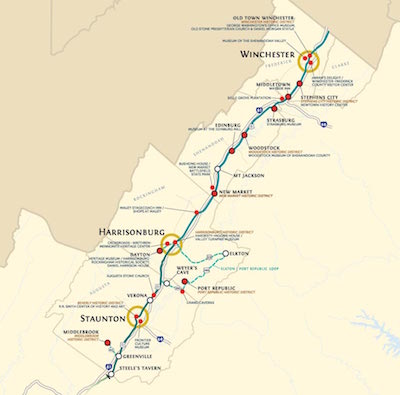 History of The Wilderness Road Migration Route in Harrisonburg
History of The Wilderness Road Migration Route in Harrisonburg
In 1737, Thomas Harrison, the son of English immigrants, settled on the land around several natural springs to make his home. The town of Harrisonburg grew up around those springs. His brothers chose to settle in other nearby locations in what would become Rockingham County. Still standing today, Harrison’s house is just a stone’s throw from historic Route 11 and Virginia’s Heritage Migration Route.
The same independent and revolutionary spirit that drove America to freedom and fueled Virginia’s Heritage Migration Route created opportunity. In the midst of the Revolutionary War, 1778, the Commonwealth of Virginia established Rockingham County. A year later, Thomas Harrison deeded two and one half acres to the public good. The town fathers used the land to build the first courthouse on what is today, Court Square. Known as Rocktown, the town continued to grow as travelers-from Iroquois to Cherokee, Scots-Irish to German, Brethren and Mennonite-stopped for the natural springs; a welcomed respite from their travels.
In 1780, Harrisonburg officially became a town. Today, Main Street runs right through the historic downtown district, included in the State and National Registers of Historic Places. In 2001, downtown Harrisonburg became one of the state’s first Cultural Arts districts, and a Virginia Mainstreet Community.
Part of the city’s unique history can be viewed through the work of quilting artisans. The Virginia Quilt Museum made its home here, and serves as a resource center for the study of the role of quilts and quilting in the cultural life of society. The museum’s permanent collection features over 150 quilts dating from 1810 to the present.
As a central location on a major thoroughfare of the Great Valley Road, Harrisonburg and Rockingham County became home to a large number of Brethren and Mennonites, Christian Anabaptist denominations that are committed to non-violence and pacifism. In the summer of 2006, CrossRoads: Valley Brethren-Mennonite Heritage Center opened its doors. CrossRoads is an interpretive center which brings to life the history of the Brethren and Mennonites. Experience their simple way of living; touch artifacts from earlier days; visit a farmstead, and attend events celebrating their heritage.
The scenic mountains certainly played a large part in why many chose the area for settlement and the Valley Turnpike became a major thoroughfare through the great Valley of Virginia. Known by many names, the natural buffalo path and game route used by Native American Indians became the road to western expansion and the wilderness attracting thousands of early pioneers.
Harrisonburg, with its wealth of natural springs and genuine hospitality, was a popular stopping point on the Wilderness Road. Many travelers along Virginia’s Heritage Migration Route became permanent residents of our area, and that heritage is evident when you experience Harrisonburg!
More information about Virginia’s Wilderness Road Heritage Migration Route
Wilderness Road Heritage Route Sites
Mauzy Stagecoach Inn/Shops at Mauzy
Intersection of Rt 11 & I81, north of Harrisonburg, Virginia
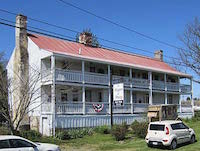 This antebellum stagecoach inn was built to serve travelers on the Valley Pike, 10 miles north of Harrisonburg. The long frame building is fronted by a two-story porch and includes a number of original outbuildings. Today it is open to the public as a collection of shops, selling gifts, decorative items and antiques.
This antebellum stagecoach inn was built to serve travelers on the Valley Pike, 10 miles north of Harrisonburg. The long frame building is fronted by a two-story porch and includes a number of original outbuildings. Today it is open to the public as a collection of shops, selling gifts, decorative items and antiques.
Hardesty-Higgins House/Valley Turnpike Museum
212 South Main Street, Harrisonburg, Virginia
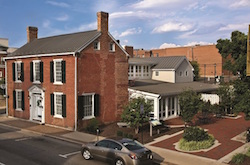 The land of Thomas and Sarah Harrison was selected in 1779 as the site for the seat of the new county of Rockingham. The town was provided with a central courthouse square, used as a model for towns across the nineteenth-century Midwest. The Hardesty-Higgins House, located directly on the route of the Great Wagon Road/Valley Turnpike, was begun by physician Henry Higgins in 1848. In addition to the Valley Turnpike Museum, which chronicles transportation through the Valley, it contains a visitor center, gift shop, and cafe.
The land of Thomas and Sarah Harrison was selected in 1779 as the site for the seat of the new county of Rockingham. The town was provided with a central courthouse square, used as a model for towns across the nineteenth-century Midwest. The Hardesty-Higgins House, located directly on the route of the Great Wagon Road/Valley Turnpike, was begun by physician Henry Higgins in 1848. In addition to the Valley Turnpike Museum, which chronicles transportation through the Valley, it contains a visitor center, gift shop, and cafe.
Driving Directions
Crossroads-Brethren-Mennonite Heritage Center
1921 Heritage Center Way, Harrisonburg, Virginia
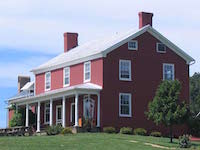 Mennonites and Brethren have lived quietly in the Valley of Virginia for over two centuries. The Crossroads Heritage Center interprets their long history of faith, their unique farming traditions, their pacifism, and their legacy of craftsmanship to tourists and members of the Brethren and Mennonite communities. It incorporates an outdoor museum, including the relocated 1854 Burkholder-Myers House, home of an important Mennonite bishop, and the Whitmer School/Cove Mennonite Church, a one-room school house/meetinghouse.
Mennonites and Brethren have lived quietly in the Valley of Virginia for over two centuries. The Crossroads Heritage Center interprets their long history of faith, their unique farming traditions, their pacifism, and their legacy of craftsmanship to tourists and members of the Brethren and Mennonite communities. It incorporates an outdoor museum, including the relocated 1854 Burkholder-Myers House, home of an important Mennonite bishop, and the Whitmer School/Cove Mennonite Church, a one-room school house/meetinghouse.
Driving Directions
Heritage Museum/Harrisonburg-Rockingham Historical Society
382 High Street, Dayton, Virginia
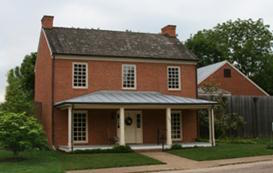 The town of Dayton grew up after 1828 along the Harrisonburg-Warm Springs Turnpike southwest of Harrisonburg. The main exhibit at the extensive Heritage Museum recounts Rockingham County’s history from the Native American period to the present. Exhibits include prehistoric artifacts, folk art, the local effects of national wars, and local economic and industrial history. The society also provides an extensive research library and a wide variety of local genealogical books for sale in the gift shop.
The town of Dayton grew up after 1828 along the Harrisonburg-Warm Springs Turnpike southwest of Harrisonburg. The main exhibit at the extensive Heritage Museum recounts Rockingham County’s history from the Native American period to the present. Exhibits include prehistoric artifacts, folk art, the local effects of national wars, and local economic and industrial history. The society also provides an extensive research library and a wide variety of local genealogical books for sale in the gift shop.
Driving Directions
Daniel Harrison House
335 Main Street, Dayton, Virginia
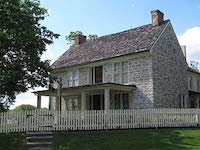 Daniel Harrison (1701–1770) moved from Delaware to Rockingham County about 1738. Daniel Harrison is thought to have built the house in 1749 and operated a grist mill, distillery, and general store at the site. The house was expanded and the windows enlarged before the Civil War. The restored house is open to the public on weekends during the warm months.
Daniel Harrison (1701–1770) moved from Delaware to Rockingham County about 1738. Daniel Harrison is thought to have built the house in 1749 and operated a grist mill, distillery, and general store at the site. The house was expanded and the windows enlarged before the Civil War. The restored house is open to the public on weekends during the warm months.
